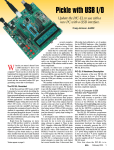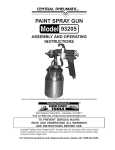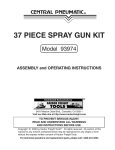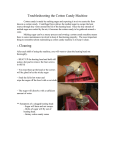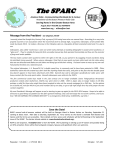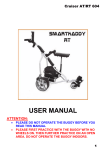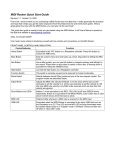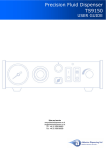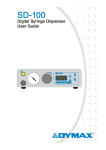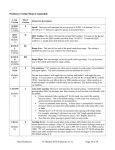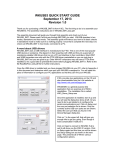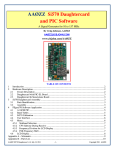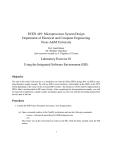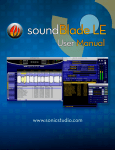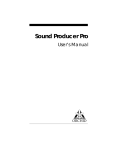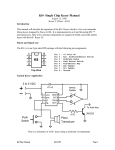Download AAØZZ EZKeyer
Transcript
AAØZZ EZKeyer Complete Construction and User’s Manual Introduction Specifications & Features Building the Board Installing in Altoids® Tin Using the Keyer Command List Schematic diagram PCB overlay Technical Stuff - Craig Johnson AAØZZ Other Stuff - Terry Fletcher, WAØITP. Page 1 AAØZZ EZKeyer Construction and user’s manual Introduction Note: This is a very simple kit to build, and if you are an experienced builder you may wish to build the board and jump ahead to Section 4. Section 4 is intended to be an Altoids tin tutorial for those who haven't used one before, or have had difficulty preparing the tins in the past. So if you‟re good at using Altoids tins, you may wish to just print out your label, install it and the board and and jump to Section 5. Before beginning the assembly please print out the Altoids label of your choice from this page and also the bottom insulator from here This full featured PIC-based iambic Morse code keyer features 3 memories and very easy use. It has many of the features of the high end keyers while maintaining ease of use. The PIC chips have been programmed by Craig Johnson, AAØZZ, of PIC-EL fame. Commands are entered directly rather than scrolling through menus. Using a PC board that is only 1.5" x 1.75", this is an EZ-to-build small footprint project with large impact on your operating capabilities, whether in the shack or in the field. It is Altoids® tin compatible, and installation instructions are included in the assembly manual. 4SQRP Group provides sample Altoids® labels in separate PDF files. Please refer to the photo page to see how your Altoids® tin installation might look. And check out the nifty labels for your favorite mint tins. The kit includes all the parts required to build the kit - push buttons, connectors, speaker, programmed PIC, transistors, caps, diodes everything but the enclosure and the mints. Page 2 AAØZZ EZKeyer Construction and user’s manual Specifications and Features 16F628A PIC based keyer Twelve direct-entry commands Three easy-to-use, 31 character memories stored in non-volatile memory (EEPROM) 5-55 wpm speed range, Iambic A or B, straight key, and Cootie Key modes Sequenced Mute Line (Goes low for rcvr or T/R switch) Default speed and modes stored in non-volatile memory (EEPROM) Speed entered by command or changed on-the-fly via the paddles Tune Mode No power switch required Current speed reported by command Operating voltage 3-5 volts, Low power - 1ma active and 1uA in sleep mode, 600 Hz sidetone (may be turned off) Autospacing between characters (may be turned off) Dash/Dot swap command Keyed line goes low when active Pressing memory #1 button when powering up causes the keyer to output the current code revision Pressing memory #2 button when powering up causes all EEPROM setting to be initialed to the default setting Holding memory buttons 2 or 3 down allows that memory’s message to be send repeatedly (beacon mode) Page 3 AAØZZ EZKeyer Construction and user’s manual Building the board Use Adobe’s zoom tool to see the pictures in detail, magnify to 200% or more. If you are installing the board in an Altoids® tin snip the upper right hand corner at approx 45 degrees as in this photo. This allows clearance with the inside rounded corner of the tin. Installing the Components There are only 10 parts to be installed on the PC board. The silk screening on the top of the board denotes the position of each component. Below is a BOM and a suggested build sequence. Check them off as you solder them in place. ___ PIC Socket Orient notch per silk-screen on board ___ C1 .1 uF Capacitor ___ Q2 BS170 MOSFET Transistor - flat side must match outline on board. ___ Q1 BS170 MOSFET Transistor - flat side must match outline on board ___ D2 1N4148 Diode - orient banded end per silk-screen on board ___ D1 1N4148 Diode - orient banded end per silk-screen on board ___ J3 1/8” Stereo Jack Mute line — mute connected to tip, ground to sleeve ___ J2 1/8” Stereo Jack Keyed line — line connected to tip, ground to sleeve ___ J1 1/8” Stereo Jack Paddle input — tip dot, dash ring, ground sleeve (std) ___ Spkr Speaker ___ 6 wire ribbon cable for push button and battery wiring ___ Snip leads flush with bottom of pcb, including the PIC socket and stereo jacks. This insures clearance with the bottom of the tin. ___ Install PIC in socket. Orient notch per silk-screen on board and the notch in the socket. Hold by the two ends, turn on it‟s and side, press down on a table top so entire side of 9 pins is bent in a bit - until they are pointing straight down. Turn over and do the same with the other 9 pins. Now both sets of pins should be aligned so it will insert easily into the socket Page 4 That’s it, the board is done. Now on to Installing it in the tin. AAØZZ EZKeyer Construction and user’s manual Installing in Altoids® Tin Label application and center punching hole locations. The Altoids label is applied at this point in the construction because it provides the template for locating the push button and stereo jack holes. The holes should be punched if possible. If you have experience drilling Altoids tins, that process may be employed also. Punching with a tool such as these is recommended, as it‟s safer and more accurate in my experience. If needed, a little material can be ground or filed off the nose of the punch so as to be able to bottom the tool and punch holes exactly 1/4 inch (midway) up from the bottom of the tin. Apply your label according to the application instructions detailed here. slides showing the process may be downloaded here These pictures may help also. Now that the label has been applied to the top of the tin. It‟s time to create the holes for the push buttons and jacks. The procedure below details the punching method. It is assumed that if you decide to drill your tin, you already have a procedure that works for you. As mentioned before, punching an Altoids® is considered more accurate, safer, and much much faster. Mark the stereo jack hole locations on the RH end of the tin. Use this hole locator template to mark the locations with a fine tip permanent marker. Click the picture to print it at actual size. Then mark the vertical location 1/4” up from the bottom. Another useful tool is a 2 x 2 block of wood with a notch in one end. It backs up the tin while center punching the holes. Clamp in a vice and it will make cleanly center punching the holes much easier. Center punching the holes A deck or drywall screw makes a good center punch The sharp point allows accuracy in placing the mark, and a light tap with a file or piece of 1 x 2 wood is all that‟s needed to create the dimple. I suggest not using a hammer. The light touch and sharp point enhances accuracy. Page 5 AAØZZ EZKeyer Construction and user’s manual Installing in Altoids® Tin The push button hole locations are noted by the 3 small circles on the label. lightly dimple their centers. Then dimple the jack locations on the end. This picture illustrates the difference between center punching and dimpling. Punching the holes is now easily accomplished. First, grasp the punching tool thusly. This grip provides complete control Punch the stereo jack holes first. They‟ will provide practice before doing the push button holes. Screw the 1/4” die in the bottom jaw, and insert the 1/4” punch in the top (movable) jaw. If you have the metric version use the 6mm set. You will have to gently use a round file or tapered reamer to slightly enlarge the holes for the jack‟s threads.Slide the end of the tin into the jaw taking care not to scratch it with the point on the punch. The key to accurate punching is to bring the tin to the punch and nestle the dimple on the point of the punch before squeezing. Another important item is to make sure the punch can penetrate the die far enough to punch the hole cleanly. Practice on a piece of card stock if you‟re uncertain of the depth needed.. If you‟ve followed the above tips, you now have a nice round hole properly placed for one of the jacks. After doing the other two, the tin should look like this. Page 6 AAØZZ EZKeyer Construction and user’s manual Installing in Altoids® Tin Punching the push button holes As mentioned previously the key to accurate punching is to bring the tin to the punch, nestle the dimple on the point of the punch, then squeeze. Punching the push button holes is as easy as the doing the stereo jack holes. You‟ll have to accommodate the lip of the lid by opening the jaws a wide as possible, and you‟ll be punching directly through the label. Screw the 5/32” die in the bottom jaw, and insert the 5/32” punch in the movable jaw. If you have a metric punch use the 4mm set, no filing or reaming will be necessary. Ensure that the die doesn‟t protrude into the space between the jaws, see picture on the left. Carefully feed the tin‟s lid into the jaws, then screw the die further in so that the slots are flush with the hole, as in the picture on the right. This enables the tool to punch the hole. . Nestle the center punch dimple onto the point of the punch and squeeze. It‟s as simple as that. Do the other two holes and your tin should look like this. If you‟re not satisfied with your first effort, try another one. It „s cheap, quick, and EZ. All good ham radio characteristics :o) Page 7 AAØZZ EZKeyer Construction and user’s manual Installing in Altoids® Tin Glue the push buttons in place, it’s easy. Before beginning make sure that you have a tube of GEL Super Glue on hand, Here are some products that have proven to work well. Notice that they all say GEL on the package. The thin variety will run under the switch and glue the push button, rendering it useless. Another caution, be sure to wear eye protection when using super glues (cyanoacrylates). Center the buttons in the holes An easy way to do this is to tape the button strip on the bottom of the lid with the buttons protruding thru the holes. Insure that the first button is centered in the hole and operates freely before smoothing down the tape. Center and glue them one at a time. Pinching the switch between the thumb and index finger can work well also, but is more prone to movement while gluing. Applying the glue Applying only one small drop at a corner to start is key.. Allow it to set up before proceeding to the next step. Accelerating the cure can be accomplished by touching the glue with a tiny drop of CA glue accelerator, water, or white glue. I use accelerator, because its fastest, and pick up the drop with a straightened paper clip. Apply it at the outside edge of the drop After the first drop is cured, lay a fillet of glue around the switch and use more accelerator or water, or just let it cure for a few hours. It will usually set up by itself. My fillets usually turn out to be globs, but they are functional. After the glue on the first hole has cured, center and glue the other two, one at a time, just like the first one. No need to use large quantities of glue. The amount in the pictures is adequate. Hang on, you‟re nearly done. Page 8 AAØZZ EZKeyer Construction and user’s manual Installing in Altoids® Tin Wire the board for battery and push buttons and insert in tin. Strip a 4 wire cable from the supplied ribbon cable. Cut each individual wire back 1/2 inch, strip 1/8” and tin. Place and solder the tinned ends in the push button holes at the bottom edge of the board. One wire is for the ground connection. Your push button wires should look like this at this point. Strip and tin the two remaining wires and solder them into the +5 V and gnd power supply connections at the top edge of the board. Print the bottom insulator, trim, and place it in the bottom of the tin prior to inserting the board Click the picture to print it at actual size. Trim the corner of board, if not already done. Insert the board into the tin with the jack threads going through their holes. Install and tighten the nuts. Page 9 AAØZZ EZKeyer Construction and user’s manual Section 4 Installingin Altoids® Tin Powering the EZKeyer Powering the keyer is left to the builder. The voltage range must be within +3 to +5.5 VDC Three AAA batteries make nice battery pack for the keyer, and the battery life should be a year or more. They can be placed in a pyramid or laid flat and wired in series for 4.5volts. A battery holder can be used also, try these: Mouser 546-BH3AAAW Digi-Key BH3AAA-W-ND There is plenty of room in the tin for the batteries. Measure the voltage before connecting the batteries to the board! Wiring the push buttons Bend the one side of the button leads over to the adjacent buttons in order to connect the ground side of the switches together. Solder the common point to the lead connected to the board ground. Cut the other lead to the length required for their respect switches, leave an extra 1/8” to strip and solder. Insure that the lead for switch #1 is cut for switch #1, etc. Solder the appropriate “hot” wire to the appropriate switch and you‟re done. Use this photo for a guide.. Page AAØZZ EZKeyer Construction and user’s manual Using the keyer Quick test before using Before the memories are loaded, lightly tap memory button #1. You should hear a morse “1” from the on board speaker, memory button #2 should return a “2”, and #3 should return a “3”. Then plug in a paddle and send a little code. If you hear the numbers and the code, all should be well. Familiarization The default speed is 15 wpm to enable most ops to begin using the commands easily. Set the speed where you like it using the S command (see next page) and send some code to get the feel of the keyer and the default settings. The iambic routines are smooth with a good “feel”, and entering commands quickly becomes second nature. Go thru the command list entering each command. This will familarize you with the procedure and features and only takes 2-3 minutes. Note: Pressing Memory #1 button while powering up will cause the keyer to output the software version number. Pressing Memory #2 button while powering up will cause the keyer to restore the default settings Using the keyer Memories For practice load memory one with a 2 x 2 CQ. It‟s very easy and when the message is sent it goes out as perfect code. Example: press and hold memory button #1 hear “R” release, send 1 (for memory #1), hear beep, send C hear beep, send Q hear beep. Wait (enters space) beep, send C hear beep, send Q hear beep, Wait hear beep, send D hear beep , send E hear beep, wait beep, W beep, A beep, 0 beep, I beep, T beep, P beep, Wait beep, W beep, A beep, 0 beep, I beep, T beep, P beep, Wait beep K beep, send period to end loading hear “R” The procedure looks complex when written out as above, but in real life is extremely easy, quick, and intuitive. To send just lightly tap button #1. The beauty of this system is that I don't have to listen to my fist as the memory is sent, the code is perfect. "Note: Pressing and holding down memory button 2 or 3 allows that message to be sent from memory repeatedly. (Beacon Mode). Pressing and releasing memory button 1 allows message 1 to be sent from memory. Pressing and holding memory button 1 down for longer than 2 seconds causes the keyer to enter command mode, send an "R" and wait or a command to be entered with the paddles." Page AAØZZ EZKeyer Construction and user’s manual Using the keyer Entering Commands: The full command list and definitions can be found on the next page. Choosing and using them is quite EZ. Here‟s some examples and their use. The general procedure is to press Memory #1 button for 2 seconds, release it, hear an “R”, and enter the command. If the command isn't understood the keyer responds with a “?” . To determine the speed the keyer is sending, Press button #1 until you hear “R”, release the button and send”W”, the keyer then sends it‟s setting via the sidetone speaker. If you want to turn off the sidetone because your rig has one you‟d rather use. Press button #1 until you hear “R”, release the button and send”A”, the keyer then sends “R” and turns off the side tone. Doing it again toggles the sidetone back on. Sideswiper/Cootie lovers will love this option. Press button #1 until you hear “R”, release the button and send ”K”, the keyer then switches to the straight/cootie key mode. Doing it again toggles the Iambic keyer back on. Setting the speed via command. Press button #1 until you hear “R”, release the button and send ”S”, the keyer answers with “dit” , you send the first digit of the speed you want (e.g. 1 for 18 wpm), the keyer sends a “dit”, you send the second digit (8 in this case), the keyer responds with “R” and switches to the new speed. Setting the speed on the fly. This is as easy as using as pot. Push button #1, quickly tap the dot lever (for faster) or dash ( or slower), release the button. You‟re then at the new speed. This change isn't stored in EEPROM, but will remain in use if you don't use an off/on power switch. Page AAØZZ EZKeyer Construction and user’s manual Command List Pushbutton 1 is also used to send commands to the keyer. If it is pressed and released quickly it sends Message 1. If it is pressed and held for about 2 seconds before releasing, the keyer responds with an "R", and goes into command mode. The user now enters one of these commands: "A" - Sidetone enable. Toggles the keyer's sidetone ON or OFF. Default is ON. Keyer response is "R" in either case. "I" - Iambic mode toggle. Toggle between Iambic-A and Iambic-B mode. Default is "Iambic-A". Keyer response is "A" or "B" for Iambic-A or Iambic-B. "K" - Keyer/Straight-key toggle. Toggles between "Keyer" mode and "Straight Key" mode. Straight key mode can use either the DIT or DAH paddle. Response is "R" in either case. "S" - Set CW speed (between 5 and 55 WPM). Keyer response is a DIT, requesting the first digit, followed by another DIT requesting the second digit. A "T" may be entered instead of a zero. Response is a "?" if the input is invalid. Default is 15 WPM. In addition, the speed can be adjusted quickly by pressing and holding the command pushbutton (PB1) and then tapping the left (usually DIT) paddle or the right (usually DAH) paddle. Each time the left paddle is tapped the speed increased by 2 WPM. Each timethe right paddle is tapped the speed is decreased by 2 WPM. The keyer responds with a DIT after each tap. (If PB1 is held for longer than about 2 seconds before the paddle is tapped, the keyer will go into command mode.) "T" - Tune. Key the output continuously - until the user taps one of the paddles. "U" - Autospace Mode Toggle*. Default is ON. Response is "A" when turned ON, "N" when turned OFF. "X" - Swap Paddles. The DIT and DAH paddles are reversed. "W" - Report Morse speed. The keyer reports the current speed. "M" - Receiver Mute Mode Toggle**. Response is "M" when toggled ON and "O" when toggled OFF. "1" Load User Message 1. The user enters characters for message 1, one character at a time. Keyer sends a DIT, requesting a character. After the character is entered and validated, the keyer responds with another DIT requesting the next character, etc. If the user wants a space he just waits for about 2 seconds and it gives another DIT, indicating the space was saved in the message. User ends the message input by entering a period. Maximum message size is 31 characters. Response is "R" at end-of-message. "2" Load User Message 2 Same as "1". "3" Load User Message 3 Same as "1" * Autospace Mode - An aid for sending good CW. When enabled you cannot send CW with two dit spaces between any two CW elements. If you try to send two spaces it will automatically add one more, making it a letter-space instead of spacing within a letter. It's hard to hear unless you slow way down and try it. ** Receiver Mute Mode - When ON, the receiver mute circuitry becomes operational. Then, when the paddle is closed (either DIT or DAH) the RX Mute output is activated, "shorting" the jack output to ground. 7 ms later the transmitter output jack is keyed, "shorting" its output to ground. After the appropriate "Dit Time" or "Dah Time" for the current CW speed the transmitter is unkeyed and 7 ms later the receiver mute is un-keyed. Note that the leading 7 mS is taken away from the DIT/DAH "ON" time and the trailing 7 mS is taken from the inter-element "OFF" time. The overall speed is constant, whether or not this feature is ON. Page AAØZZ EZKeyer Construction and user’s manual Schematic Page AAØZZ EZKeyer Construction and user’s manual Page Links To Suitable hand Punches Harbor Freight Grizzly Northern Back To Page 5 Page
















